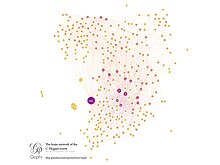Brain simulation is the concept of creating a functioning computer model
of a brain or part of a brain. Modelling a brain (or brain subsystem)
involves both modelling neurons' electrical and bulk chemical properties
(e.g. extracellular serotonin gradients). A model of the neural connectome
of the target organism is also required. The connectome is extremely
complex, and its detailed wiring is not yet understood; thus it is
presently being modeled empirically in smaller mammals by projects like
the Blue Brain Project.
The Blue Brain Project intends to create a computer simulation of a mammalian cortical column down to the molecular level. By one estimate, a full reconstruction of the human connectome using the methodology of the Blue Brain Project would require a zettabyte of data storage. In 2013, Human Brain Project created a Brain Simulation Platform (BSP), which is an internet-accessible collaborative platform designed for the simulation of brain models. The Human Brain Project has utilized techniques used by the Blue Brain Project and built upon them.
Brain simulation projects intend to contribute to a complete understanding of the brain, and eventually assist the process of treating and diagnosing brain diseases.
The Blue Brain Project intends to create a computer simulation of a mammalian cortical column down to the molecular level. By one estimate, a full reconstruction of the human connectome using the methodology of the Blue Brain Project would require a zettabyte of data storage. In 2013, Human Brain Project created a Brain Simulation Platform (BSP), which is an internet-accessible collaborative platform designed for the simulation of brain models. The Human Brain Project has utilized techniques used by the Blue Brain Project and built upon them.
Brain simulation projects intend to contribute to a complete understanding of the brain, and eventually assist the process of treating and diagnosing brain diseases.
Caenorhabditis elegans (roundworm)
Brain map of the C. elegans roundworm 302 neurons, interconnected by 5000 synapses
The connectivity of the neural circuit for touch sensitivity of the simple C. elegans nematode (roundworm) was mapped in 1985 and partly simulated in 1993.
Since 2004, many software simulations of the complete neural and
muscular system have been developed, including simulation of the worm's
physical environment. Some of these models have been made available for
download.
However, there is still a lack of understanding of how the neurons and
the connections between them generate the surprisingly complex range of
behaviors that are observed in the relatively simple organism.
This contrast between the apparent simplicity of how the mapped neurons
interact with their neighbours, and exceeding complexity of the overall
brain function, is an example of an emergent property. This kind of emergent property is paralleled within artificial neural networks, the neurons of which are exceedingly simple compared to their often complex, abstract outputs.
Drosophila neural system
The brain of the fruit fly, Drosophila, has also been thoroughly studied. A simulated model of the fruit fly's brain offers a unique model of sibling neurons.
Mouse brain mapping and simulation
Henry Markram mapped the types of neurons within the mouse brain and their connections between 1995 and 2005.
In December 2006, the Blue Brain project completed a simulation of a rat's neocortical column. The neocortical column is considered the smallest functional unit of the neocortex.
The neocortex is the part of the brain thought to be responsible for
higher-order functions like conscious thought, and contains 10,000
neurons in the rat brain (and 108 synapses). In November 2007,
the project reported the end of its first phase, delivering a
data-driven process for creating, validating, and researching the
neocortical column.
An artificial neural network described as being "as big and as complex as half of a mouse brain" was run on an IBM Blue Gene
supercomputer by the University of Nevada's research team in 2007. Each
second of simulated time took ten seconds of computer time. The
researchers claimed to observe "biologically consistent" nerve impulses
that flowed through the virtual cortex. However, the simulation lacked
the structures seen in real mice brains, and they intend to improve the
accuracy of the neuron and synapse models.
Blue Brain and the rat
Blue Brain is a project that was launched in May 2005 by IBM and the Swiss Federal Institute of Technology in Lausanne. The intention of the project was to create a computer simulation of a mammalian cortical column down to the molecular level. The project uses a supercomputer based on IBM's Blue Gene
design to simulate the electrical behavior of neurons based upon their
synaptic connectivity and ion permeability. The project seeks to
eventually reveal insights into human cognition and various psychiatric
disorders caused by malfunctioning neurons, such as autism, and to understand how pharmacological agents affect network behavior.
Human Brain Project
The Human Brain Project (HBP) is a 10-year program of research funded by the European Union. It began in 2013 and employs around 500 scientists across Europe. It includes 6 platforms:
- Neuroinformatics (shared databases),
- Brain Simulation
- High-Performance Analytics and Computing
- Medical informatics (patient database)
- Neuromorphic computing (brain-inspired computing)
- Neurorobotics (robotic simulations).
The Brain Simulation Platform (BSP) is a device for
internet-accessible tools, which allows investigations that are not
possible in the laboratory. They are applying Blue Brain techniques to
other brain regions, such as the cerebellum, hippocampus, and the basal ganglia.
Open-source brain simulations
Models of the brain have been released as Open-source software (OSS) and are available on sites such as GitHub. These include the C. elegans roundworm, the Drosophila fruit fly, and the human brain models Elysia and Spaun, which is based on the NENGO software architecture and is the world's largest functional brain model.
The Blue Brain Project Showcase illustrates how models and data from the Blue Brain Project can be converted to NeuroML and PyNN (Python neuronal network models).

